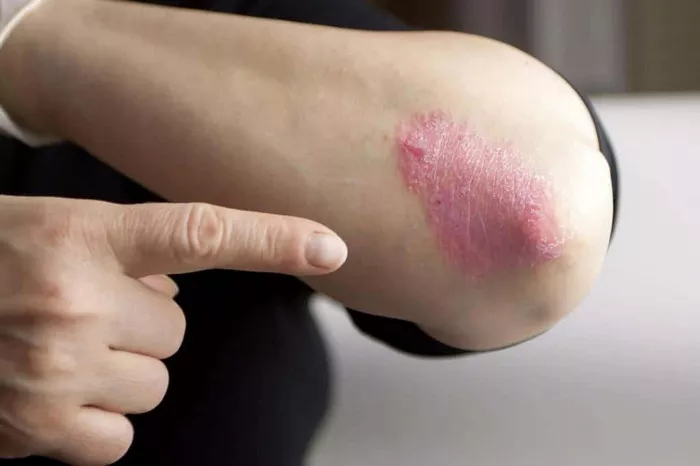Psoriasis is a chronic autoimmune condition characterized by the rapid buildup of skin cells, leading to scaling, inflammation, and discomfort. Among the different types of psoriasis, guttate psoriasis is a distinct subtype that often manifests suddenly and uniquely. Acute guttate psoriasis presents with small, drop-like lesions on the skin and can be triggered by specific factors. Understanding the nature of acute guttate psoriasis is essential for accurate diagnosis and effective management.
What is Acute Guttate Psoriasis?
Acute guttate psoriasis is a variant of psoriasis that appears suddenly, often following a bacterial or viral infection, such as streptococcal throat infections. The word “guttate” comes from the Latin word “gutta,” meaning drop, referring to the small, drop-like lesions that characterize this form of psoriasis. Unlike other forms of psoriasis that often present with larger, more defined plaques, guttate psoriasis typically features numerous small, scaly papules that appear predominantly on the trunk, limbs, and scalp.
Symptoms of Acute Guttate Psoriasis
The symptoms of acute guttate psoriasis are distinctive and can develop rapidly. Common signs and symptoms include:
1. Small, Reddish Lesions: The hallmark of guttate psoriasis is the appearance of tiny, red spots or papules on the skin. These lesions are usually less than 1 centimeter in diameter and may be covered with a fine scale.
2. Scaliness: The lesions often have a characteristic fine scale that gives the skin a silvery appearance.
3. Itching or Discomfort: Guttate psoriasis lesions can be itchy or sore, particularly if they are widespread.
4. Distribution: Lesions typically appear on the trunk, limbs (especially the arms), and scalp. They may also affect the face, ears, and neck.
5. Potential Triggers: Acute guttate psoriasis is commonly triggered by bacterial infections, especially streptococcal throat infections, as well as viral respiratory infections.
Causes of Acute Guttate Psoriasis
The exact cause of guttate psoriasis is not fully understood, but it is believed to be a combination of genetic and environmental factors. Key factors implicated in triggering acute guttate psoriasis include:
1. Infections: The most common trigger is streptococcal infections, particularly strep throat. Other infections, such as respiratory infections, can also induce guttate psoriasis.
2. Genetics: Certain genetic factors may predispose individuals to developing guttate psoriasis in response to triggers like infections.
3. Immune System: Guttate psoriasis is considered an autoimmune condition where the immune system mistakenly attacks healthy skin cells, leading to rapid skin cell turnover and inflammation.
Diagnosis of Acute Guttate Psoriasis
Diagnosing acute guttate psoriasis typically involves a thorough physical examination by a dermatologist or healthcare provider. The diagnosis is primarily based on the appearance of the skin lesions and the patient’s medical history, particularly any recent infections. In some cases, a skin biopsy may be performed to confirm the diagnosis and rule out other skin conditions.
Treatment Options for Acute Guttate Psoriasis
Treatment of acute guttate psoriasis aims to reduce inflammation, alleviate symptoms, and prevent flare-ups. The approach to treatment may include:
1. Topical Treatments: Corticosteroid creams or ointments are commonly prescribed to reduce inflammation and itching.
2. Phototherapy (Light Therapy): Exposure to ultraviolet (UV) light can help slow the growth of affected skin cells and reduce inflammation.
3. Systemic Medications: In severe cases or when topical treatments are insufficient, systemic medications such as oral retinoids, methotrexate, or cyclosporine may be prescribed.
4. Antibiotics: If a streptococcal infection triggered the psoriasis outbreak, antibiotics may be prescribed to eradicate the infection and potentially improve the psoriasis symptoms.
5. Moisturizers: Keeping the skin well-moisturized can help reduce scaling and discomfort.
Prognosis and Outlook
Acute guttate psoriasis often responds well to treatment, and many cases clear up completely with appropriate care. However, individuals with guttate psoriasis may be at a higher risk of developing other forms of psoriasis later in life. It’s essential for patients to work closely with healthcare providers to manage symptoms effectively and prevent future flare-ups.
Conclusion
Acute guttate psoriasis is a distinct variant of psoriasis characterized by sudden onset and small, drop-like lesions on the skin. It is commonly triggered by infections, particularly streptococcal infections. Understanding the symptoms, causes, and treatment options for acute guttate psoriasis is crucial for accurate diagnosis and effective management. If you suspect you have guttate psoriasis or experience symptoms, consult a dermatologist or healthcare provider for proper evaluation and treatment. With appropriate care, most individuals with acute guttate psoriasis can achieverelief from symptoms and maintain healthy skin.
Related Topics:

























